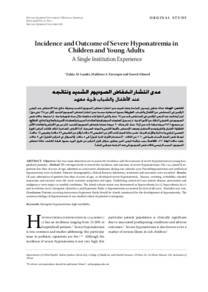Document
Incidence and outcome of severe hyponatremia in children and young adults : a single institution experience.
Contributors
Farooqui, Mahfooz A., Author
Ahmed, Saeed., Author
Other titles
مدى انتشار انخفاض الصوديوم الشديد ونتائجه عند الأطفال والشباب : تجربة معهد
Publisher
College of Medicine, Sultan Qaboos University.
Gregorian
2006-04
Language
English
Subject
English abstract
Objective: Our two main objectives are to assess the incidence and the outcome of severe hyponatremia in young hospitalized patients. Method: We retrospectively reviewed the incidence and outcome of severe hyponatremiac (Na <125 mmol/l) inpatients less than 18 years of age, admitted as consecutive admissions during one calender year. Psuedohyponatremia and artifactual hyponatremia were excluded. Patients' demographics, clinical features, laboratory, treatment and outcomes were recorded. Results: Of 3561 admissions of patients less than 18 years of age, 20 developed severe hyponatremia. Nausea, vomiting, irritability, clouded sensorium and seizures were the most common symptoms and signs. Underlying central nervous system disease, pneumonia and malignancy were major co-morbid conditions. The initial volume status was determined as hypervolemia (n=7), hypovolemia (n=7) and euvolemia (n=6). Iatrogenic (diuretics 5 and hypotonic fluids 7) hyponatremia accounted for 60% of all cases. Mortality was 20%. Conclusion: Patients receiving intravenous hypotonic fluids should be closely monitored for the development of hyponatremia. The common etiology of hyponatremia in our studied cohort of patients is iatrogenic.
Member of
Resource URL
Citation
Al-Lamkiyah, Zakia, Farooqui, Mahfooz A., & Ahmed, Saeed (2006). Incidence and Outcome of Severe Hyponatremia in Children and Young Adults : A Single Institution Experience. Sultan Qaboos University Medical Journal, 6 (1), 13–16.
Arabic abstract
الهدف: هناك هدفين رئيسيين للدراسة وهما تقييم مدى انتشار انخفاض الصوديوم الشديد ومعرفة نتائج هذا الانخفاض عند المرضى الراقدين في المستشفى من الأطفال والشباب. الطريقة بصورة استعادية حسبنا مدى انتشار انخفاض الصوديوم الشديد أقل من ۱۲۵ ملي مول / ليتر) ونتائجه عند المرضى الراقدين في المستشفى تحت سن ١٨ سنة. والذين أدخلوا لمرات متتابعة خلال سنة تقويمية واحدة تم استبعاد حالات نقص الصوديوم غير الحقيقي الناتجة عن الأمور الفنية. تم تسجيل المعلومات الديموغرافية والعلامات السريرية والمعطيات المختبرية والعلاج والنتائج النتائج من مجموع ٣٥٦١ مريضا مرقدا تحت سن ال ١٨ سنة. كان هناك ۲۰ مريضا مصابا بانخفاض الصوديوم الشديد. كان من بين الأعراض والعلامات الأكثر انتشارا الغثيان والتقيؤ وعدم الاستقرار وضعف الإحساس بالمحيط الخارجي والنوبات الصرعية. أما الأعراض المصاحبة لذلك فكانت أمراض الجهاز العصبي المركزي وذات الرئة والأورام الخبيثة. تقدير حالة الحجم كانت أكثر من الطبيعي (۷) حالات) وأقل من الطبيعي (۷) حالات) وطبيعي (1) حالات). لوحظ نقص الحجم لأسباب طبية في ٦٠٪ من الحالات - استخدام الأدوية المدرة للبول في ٥ .حالات والسوائل ذي التركيز القليل) في ٧ حالات. بلغت حالات الوفاة ٢٠. الخلاصة: يجب مراقبة المرضى الذين يعطون سوائل قليل التركيز عن طريق الوريد بصورة دقيقة لكشف حالة انخفاض الصوديوم. السبب الرئيسي لحالات نقص الصوديوم في هذه الدراسة هو طبي المنشأ.
Category
Journal articles

